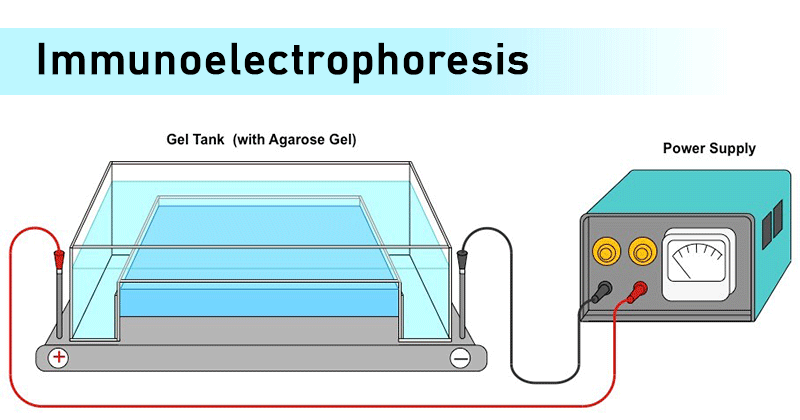- Immunoelectrophoresis refers to precipitation in agar under an electric field.
- It is a process of a combination of immuno-diffusion and electrophoresis.
- An antigen mixture is first separated into its component parts by electrophoresis and then tested by double immuno-diffusion.
- Antigens are placed into wells cut in a gel (without antibody) and electrophoresed. A trough is then cut in the gel into which antibodies are placed.
- The antibodies diffuse laterally to meet diffusing antigens, and lattice formation and precipitation occur permitting determination of the nature of the antigens.
- The term “immunoelectrophoresis” was first coined by Grabar and Williams in 1953.

Interesting Science Videos
Principle of Immunoelectrophoresis
When an electric current is applied to a slide layered with gel, the antigen mixture placed in wells is separated into individual antigen components according to their charge and size. Following electrophoresis, the separated antigens are reacted with specific antisera placed in troughs parallel to the electrophoretic migration and diffusion is allowed to occur. Antiserum present in the trough moves toward the antigen components resulting in the formation of separate precipitin lines in 18-24 hrs, each indicating reaction between individual proteins with its antibody.
Procedure of Immunoelectrophoresis
- Agarose gel is prepared on a glass slide put in a horizontal position.
- Using the sample template, wells are borne on the application zone carefully.
- The sample is diluted 2:3 with protein diluent solution (20μl antigen solution +10 μl diluent).
- Using a 5 μl pipette, 5 μl of control and sample is applied across each corresponding slit (Control slit and Sample slit).
- The gel is placed into the electrophoresis chamber with the samples on the cathodic side, and electrophoresis runs for 20 mins/ 100 volts.
- After electrophoresis completes, 20 μl of the corresponding antiserum is added to troughs in a moist chamber and incubated for 18- 20 hours at room temperature in a horizontal position.
- The agarose gel is placed on a horizontal position and dried with blotter sheets.
- The gel in saline solution is soaked for 10 minutes and the drying and washing repeated twice again.
- The gel is dried at a temperature less than 70°C and may be stained with protein staining solution for about 3 minutes followed by decolorizing the gel for 5 minutes in distaining solution baths.
- The gel is dried and results evaluated.
Results of Immunoelectrophoresis
- The presence of elliptical precipitin arcs represents antigen-antibody interaction.
- The absence of the formation of precipitate suggests no reaction.
- Different antigens (proteins) can be identified based on the intensity, shape, and position of the precipitation lines.
Applications of Immunoelectrophoresis
- The test helps in the identification and approximate quantization of various proteins present in the serum. Immunoelectrophoresis created a breakthrough in protein identification and in immunology.
- Immunoelectrophoresis is used in patients with suspected monoclonal and polyclonal gammopathies.
- The method is used to detect normal as well as abnormal proteins, such as myeloma proteins in human serum.
- Used to analyze complex protein mixtures containing different antigens.
- The medical diagnostic use is of value where certain proteins are suspected of being absent (e.g., hypogammaglobulinemia) or overproduced (e.g., multiple myeloma).
- This method is useful to monitor antigen and antigen-antibody purity and to identify a single antigen in a mixture of antigens.
- Immunoelectrophoresis is an older method for qualitative analysis of M-proteins in serum and urine.
- Immunoelectrophoresis aids in the diagnosis and evaluation of the therapeutic response in many disease states affecting the immune system.
Advantages of Immunoelectrophoresis
- Immunoelectrophoresis is a powerful analytical technique with high resolving power as it combines the separation of antigens by electrophoresis with immunodiffusion against an antiserum.
- The main advantage of immunoelectrophoresis is that a number of antigens can be identified in serum.
Limitations of Immunoelectrophoresis
- Immunoelectrophoresis is slower, less sensitive, and more difficult to interpret than Immunofixation electrophoresis.
- IEP fails to detect some small monoclonal M-proteins because the most rapidly migrating immunoglobulins present in the highest concentrations may obscure the presence of small M-proteins.
- The use of immunoelectrophoresis in food analysis is limited by the availability of specific antibodies.
References
- Lydyard, P.M., Whelan,A.,& Fanger,M.W. (2005).Immunology (2 ed.).London: BIOS Scientific Publishers.
- Parija S.C. (2012). Textbook of Microbiology & Immunology.(2 ed.). India: Elsevier India.
- http://www.hellabio.com/E89B86BA.en.aspx
- Actor, J.K. (2014). Assessment of Immune Parameters and Immunodiagnostics. Introductory Immunology. Pages 135-152
- Sastry A.S. & Bhat S.K. (2016). Essentials of Medical Microbiology. New Delhi : Jaypee Brothers Medical Publishers.

Thank you so much, sir, for your hard work to make us understand the complex biological and biotechnological mysteries in such an easy and simple way.
This is wonderful and detailed
Thank you so much
Your notes are very nice and helpful to me .
Really very good information, but if is it in protocol format then will help more.
Cannot beat it! So good! Science is awesome / 🌼